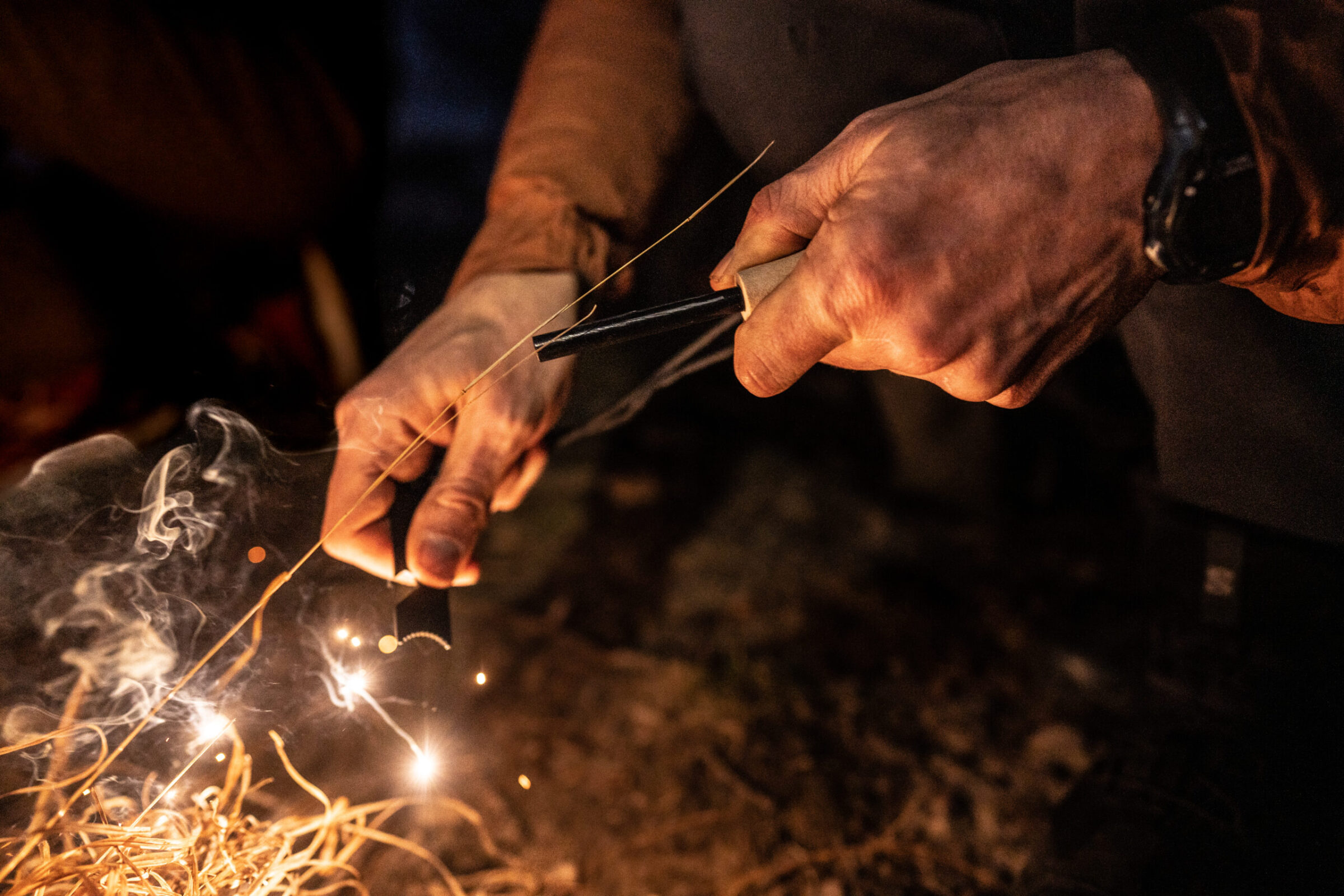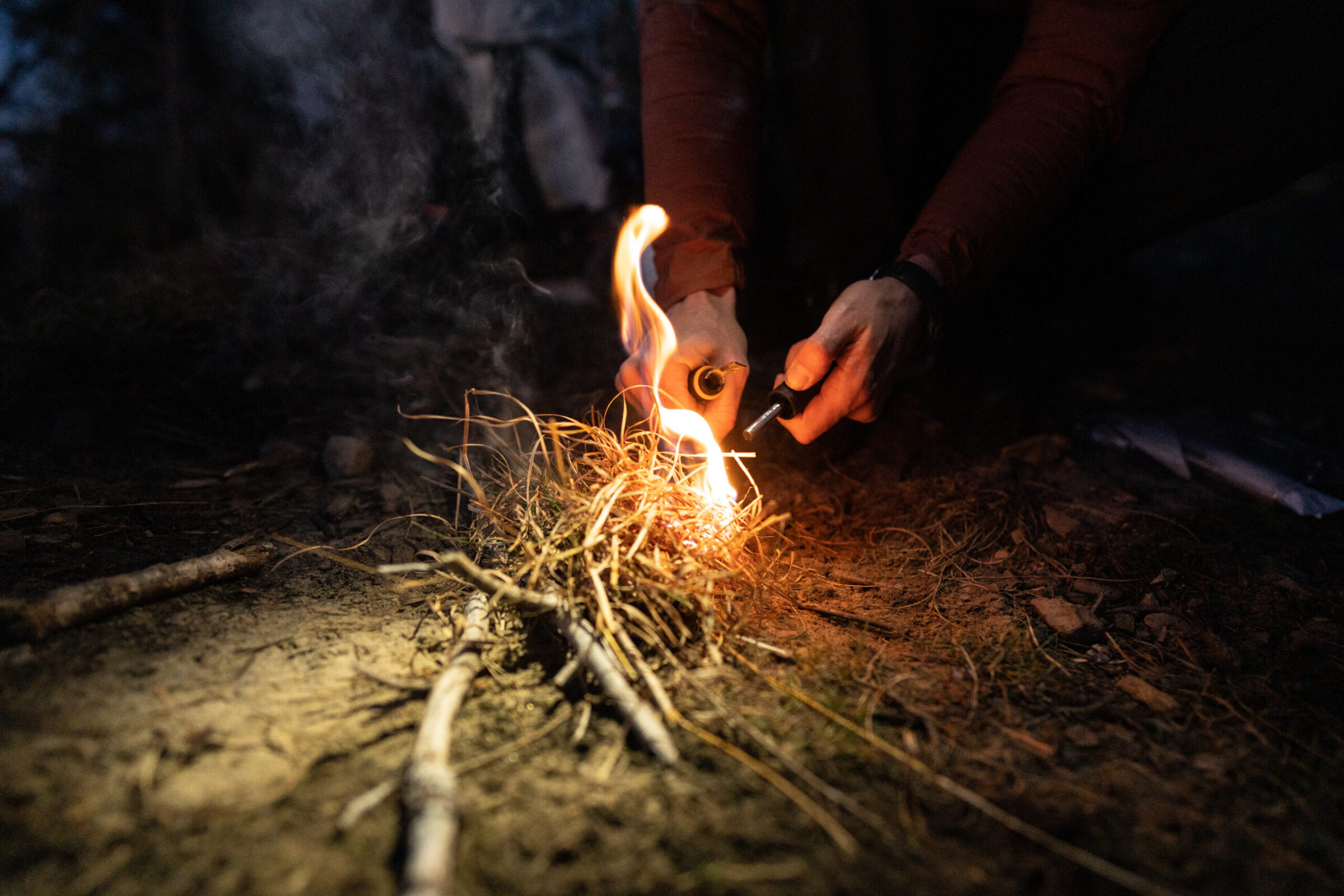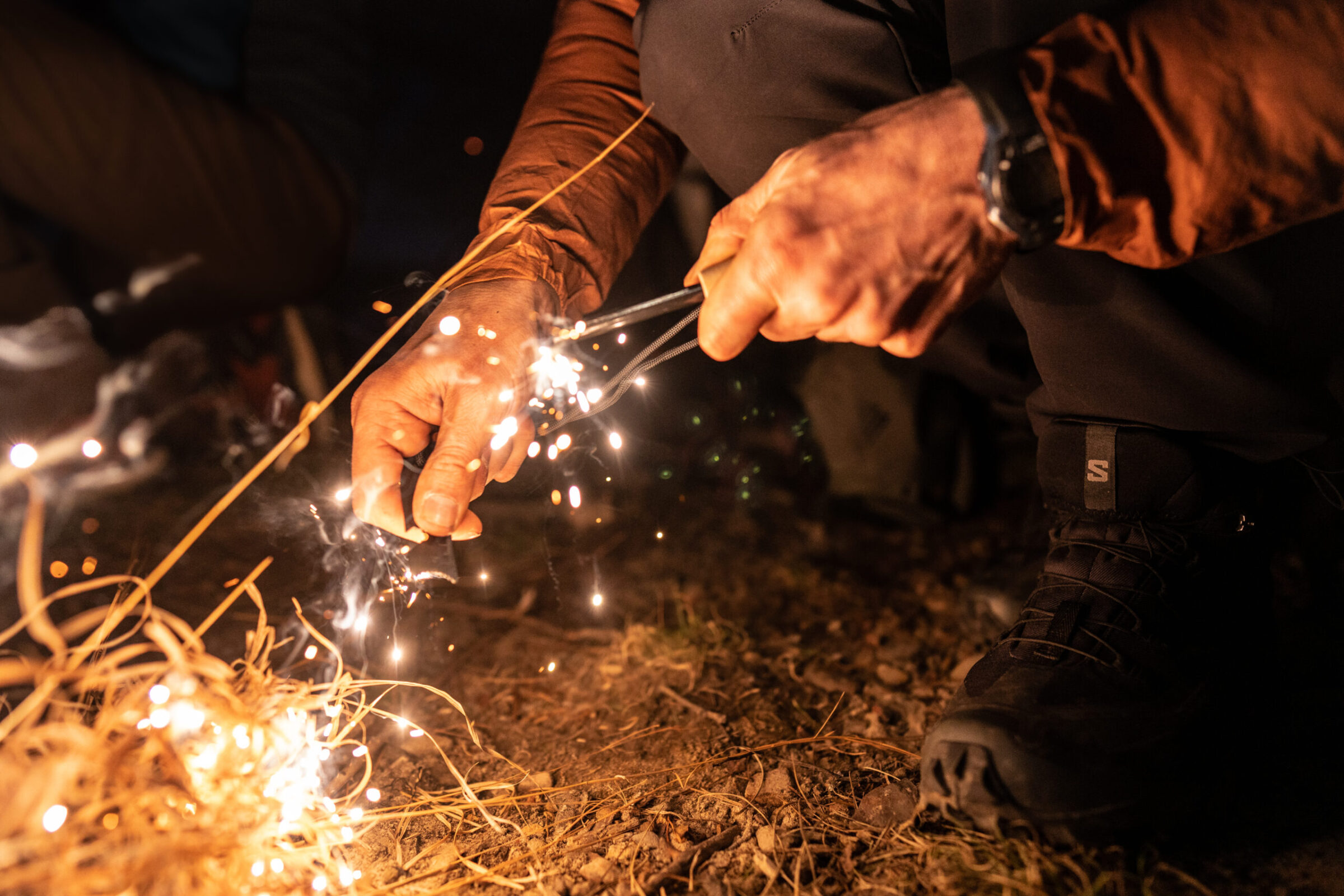The Best Firestarters of 2025
Top Picks
Best Natural Firestarter
UCO Stormproof Sweetfire Fire Starter Points – Package of 8
- Material: Ferro rod, steel striker, paracord with jute core
- Lifespan: 20,000 strikes
- Size: 4.9” x 0.8”
- Other Features: Emergency tinder, can be sharpened and stacked on the rod
Pros
- Lightweight and compact
- Long lifespan
- Simple design
Cons
- No space for grip
- Material: Pine
- Lifespan: Enough for more than 10 fires
- Size: 56.0” x 0.8” x 0.8”
- Other Features: 80% resin content, rope attached for easy carry
Pros
- Highly combustible in any conditions
- Can be used with any ignition source, affordable
Cons
- Need to carry separate igniter
- Material: Flint-based bar with plastic carrier
- Lifespan: 4,000 strikes
- Size: 4.1” x 1.4”
- Other Features: One-handed use, 360-degree flint rotation, waterproof housing
Pros
- Easy to use
- Fits in small pockets
- Distributes wear and tear
Cons
- Method takes some work to get down
- Doesn’t last as long as others
- Material: Bagasse (Sugarcane waste), infused with vegetable wax
- Lifespan: 8 matches that burn for 7 minutes each
- Size: 3.2” x 2.6” x 1.2” (individual); 5.5" x .75" x .4" (box)
- Other Features: Each match point has a strike-able tip that can conveniently be used with the striker on the box
Pros
- Renewable resource
- Burns through wet/damp materials with ease
- Affordable and easy to strike
Cons
- Does not hold up well with wind stronger than a moderate breeze
- Single-use ignition
- Material: 3.9″ hardened 12C27 stainless steel blade, magnesium alloy firestarter
- Lifespan: 3,000 strikes
- Size: 9.4” x 4.1” x 2.5”
- Other Features: Firestarter twist locks into the handle
Pros
- Two-in-one knife and firestarter
- Low-maintenance and high-quality knife blade
- Catches on tinder easily
Cons
- Firestarter has a short lifespan
- Material: Propane fuel, steel container
- Lifespan: Varies depending on use
- Size: N/A
- Other Features: Burns at 34000 degrees F, self-igniting trigger
Pros
- Lights just about anything
- Easy to use and completely hassle-free
- Long reach of the flame
Cons
- Need to replace fuel more often
- Takes up a lot of space and weight
- Material: Unavailable
- Lifespan: 12 matches that burn for 25 seconds each
- Size: 4.125”
- Other Features: 3 replaceable strikers, waterproof and buoyant case
Pros
- Easy to use
- Simple match style ignition
- Worth the price in case of emergencies
Cons
- Limited use
- Screw top is notoriously finicky
More Fire Starters We Tested
- Material: Ferro rod, metal striker, cotton tinder, plastic casing
- Lifespan: N/A
- Size: 4.75" x 1.1"
- Other Features: 100 decibel whistle, water-resistant tinder capsule
Pros
- Compact design with striker and ferro rod
- Tinder capsule
- Included whistle
Cons
- Short rod
- Lanyard limits range of motion while striking
- Material: Flint, magnesium, and steel
- Lifespan: Over 100 fires
- Size: 8.66” x 4.13” x 1.18”
- Other features: Bottle opener included on steel striker
Pros
- Robust handle enhances grip
- Magnesium reaches high temperatures for easy lighting
- Great price for a multipurpose tool
Cons
- Heavier than we expected
- Material: Plasma lighter, plastic case
- Lifespan: N/A
- Size: 3.75" x 1"
- Other Features: 120-lumen built-in flashlight
Pros
- Weatherproof design
- Can light a fire in windy environments
- Integrated flashlight
- Rechargeable
Cons
- Not the best battery life
- Material: Ferro rod, 550 paracord, metal scraper
- Lifespan: 12,000 strikes (trad), 15,000 strikes (pro), or 20,000 strikes (fatty)
- Size: 2.5” x 0.31", 0.38", or 0.5"
- Other Features: Paracord lanyard, multitool scraper included
Pros
- Comfortable wood grip
- Affordable
- Multifunctional, effective scraper
Cons
- Ferro rod length is a bit short
- Material: Ferro rod, steel striker, pine tinder
- Lifespan: Five pine tinder shreds burn up to 8 minutes each; the lifespan of ferro rod and striker depends on the frequency of use
- Size: 1.5” x 6.63” x 6”
- Other Features: Five paraffin-coated pine tinder bundles, collapsible stainless steel bellows
Pros
- Has everything you need in one package
- Bellows help you keep the fire going once started
- Affordable
Cons
- Small pieces can be lost easily
- Only five tinder bundles, so you will need more
- Material: Plasma lighter, plastic case, cord lanyard
- Lifespan: 45 uses in one charge (Each use = 7 seconds)
- Size: 4" x 1.4"
- Other Features: 3-foot tinder-cord lanyard, 100-lumen built-in flashlight, 2-hour charge time
Pros
- Dependable in just about any environment
- Easy to use
- Emergency flashlight and tinder
- Quick-charging lithium battery
Cons
- Needs to be charged every so often
- Won’t light anything too wet
- Material: Ferro rod, paracord lanyard, aluminum handle, cotton tinder
- Lifespan: 10,000 strikes
- Size: 3.55" x 0.55" x 0.55"
- Other Features: Tinder capsule, cotton tinder included
Pros
- Perfect dimensions for ferro loops on knife sheaths
- Handy waterproof tinder capsule
- Can add replacement ferro rods
Cons
- Somewhat short rod
- Doesn't come with its own striker
- Material: Plastic, ferro rod, reflective paracord, steel
- Lifespan: 3,000-12,000 strikes
- Size: 3.8" by 1"
- Other features: Striker doubles as a bottle opener
Pros
- Reliable
- Lasts a while
- Works for stoves and fires
- Produces a good spark
Cons
- Bottle opener design could be better
- Material: Ferro rod, aluminum housing, steel striker, wax-infused hemp rope tinder
- Lifespan: Unsure, but rope stays lit for 3+ hours. Ferro rod takes thousands of strikes
- Size: 6" x 0.6" x 1"
- Other Features: Hemp tinder rope and striker included
Pros
- Convenient all-in-one package
- Incredibly easy to fray rope and get it to take a spark
- Rope stays lit for 3+ hours if need be
- Easy to extinguish rope once tinder bundle is lit
Cons
- Ferro rod would get difficult to strike once it wears down past aluminum housing
- Tinder rope is hard to ignite if it gets wet
- Heavier than others
Firestarter Comparison Chart
| Firestarter | Price | Material | Lifespan | Size | Main feature |
| Wolf & Grizzly | $27 | Ferro rod, steel striker, paracord | 20,000 strikes | 4.9” x 0.8” | Emergency tinder |
| Light My Fire MayaStick-on-a-Rope | $4 | Pine | Enough for more than 10 fires | 6.0” x 0.8” x 0.8” | 80% resin content |
| UST BlastMatch | $20 | Flint-based bar with plastic carrier | 4,000 strikes | 4.1” x 1.4” | Waterproof housing |
| UCO Stormproof Sweetfire Fire Starter Points | $6 | Bagasse (Sugarcane waste), infused with vegetable wax | 8 matches that burn for 7 minutes each | 3.2” x 2.6” x 1.2” (individual); 5.5″ x .75″ x .4″ (box) | Natural |
| Morakniv Companion Spark | $30 | Stainless steel blade, magnesium alloy firestarter | 3,000 strikes | 9.4” x 4.1” x 2.5” | Firestarter twist locks into the handle |
| Bernzomatic Trigger-Start Torch | $56 | Propane fuel, steel container | Varies depending on use | N/A | Burns at 3,400 degrees F |
| UCO Titan Stormproof Match Kit | $12 | N/A | 12 matches that burn for 25 seconds each | 4.125” | 3 replaceable strikers, waterproof and buoyant case |
| Gerber Fire Starter | $20 | Ferro rod, metal striker, cotton tinder, plastic casing | N/A | 4.75″ x 1.1″ | 100 decibel whistle |
| SOL Mag Striker with Tinder Cord | $14 | Flint, magnesium, and steel | Over 100 fires | 8.66” x 4.13” x 1.18” | Bottle opener included on steel striker |
| Dark Energy Plasma Lighter | $30 | Plasma lighter, plastic case | N/A | 3.75″ x 1″ | 120-lumen built-in flashlight |
| Überleben Zünden Fire Starter | $16 | Ferro rod, 550 paracord, metal scraper | 12,000 – 20,000 strikes | 2.5” x 0.31″, 0.38″, or 0.5″ | Multitool scraper |
| Zippo Firestarter Kit | $22 | Ferro rod, steel striker, pine tinder | Tinder shreds burn 8 min each | 1.5” x 6.63” x 6” | Five paraffin-coated pine tinder bundles |
| SOL Fire Light electric lighter | $28 | Plasma lighter, plastic case | 45 uses in one charge | 4″ x 1.4″ | 3-foot tinder-cord lanyard |
| Exotac Firerod | $33 | Ferro rod, paracord lanyard, aluminum handle, cotton tinder | 10,000 strikes | 3.55″ x 0.55″ x 0.55″ | Waterproof tinder capsule |
| MSR Strike Igniter | $18 | Plastic, ferro rod, reflective paracord, steel | 3,000 – 12,000 strikes | 3.8″ by 1″ | Striker doubles as a bottle opener |
| Prepared4X Survival Torch | $22-25 | Ferro rod, aluminum housing, steel striker, wax-infused hemp rope tinder | N/A | 6″ x 0.6″ x 1″ | Hemp tinder rope and striker included |

How We Tested the Best Firestarters

Buyer’s Guide: How to Choose the Best Firestarter

Type of Activity

Size & Weight
Ease of Use

Types of Firestarters
Flint and Steel

Ferrocerium Rods (Ferro Rod)


Magnesium Bars
Firemaking Tips


Reliability
Price & Value
Budget
Mid-Tier
Premium

Frequently Asked Questions
The best firestarter is the one that best fits your needs and your budget. The firestarter that you feel comfortable using when you need it to work, and doesn’t cost a fortune, is the best firestarter. The best firestarter is one that helps you skip having to learn how to start a fire with sticks and friction alone.
Some people prefer using a Bic lighter, while others love a ferro rod and striker’s reliability. In the end, it’s all about opinion and experience. Test out multiple types to find what fits you best.
Firestarters all work in different ways. A flint and steel method, or a striker and fire rod made from different materials, will work with simple science.
The hardness of the two materials and the contact between the two results in sparks. Your striker needs to be harder than what you are striking it on.
While the firestriker scrapes away a bit of the fire rod, the ripping apart of the material and the friction of the two objects both play a part in shooting small, insanely hot pieces of metal in the direction you want them to go. They stay hot enough in the air (hopefully) to reach your tinder and transfer heat into the dry tinder, resulting in a fire.
Bear Grylls is seen as the Olympian of outdoor survival by many. Still, it’s important to remember that he only uses tools that work well for him.
Bear Grylls teamed up with Gerber to make his idea of the best possible firestarter for survival. They came up with the Gerber Bear Grylls Survival Series Fire Starter, which is essentially the Gerber Fire Starter that we reviewed above, plus his initials. While this is what he came up with, we can imagine Bear used a wide array of different firestarters to figure out what works best for him.
Magnesium firestarters have a magnesium block attached to a small ferro rod strip that together can make sparks. Scrape the magnesium off with a knife or the provided striker, and then build up a small pile of the shavings.
This is what you want to strike into. Once the spark catches, the magnesium will burn hot, fast, and bright.
Magnesium doesn’t work alone as tinder to start a fire. You still need to find dry tinder to place the shavings inside. Magnesium burns around 4,000 degrees F, which helps get a fire started more quickly, but it can take a lot of work to get enough shavings from the magnesium block.

The Best Bushcraft Knives of 2025
Whether splitting logs or whittling by the fire, we’ve found the best bushcraft knives for every budget and use.

The Best Backpacking Stoves of 2025
The right stove makes life on the trail better. From ultralight canisters to four-season and multifuel options, we’ve found and tested the best backpacking stoves.


























